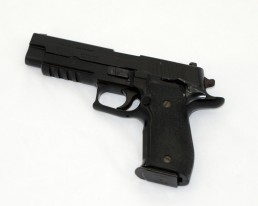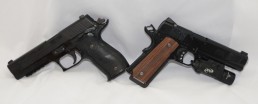Month: December 2013
ZAUF: Introduction to Caliber
The next part of our Zen and the Art of Understanding Firearms (ZAUF) series is still part of the introduction. This entry in the series will teach you what it means when people say “.45 Caliber”, “9 millimeter”, or “12 gauge”.
With these designators, it comes down to differences between the region of origin: American vs the rest of the world. When someone says “a 45” or “45 caliber”, what do they mean? 45 of what? 0.45 of an inch, of course. So what does that mean exactly? The width at the widest part of the given bullet is approximately .45 of an inch wide in diameter. We say “approximately” because if you wanted to extend significant figures out to the thousandths place and beyond you’ll quickly realize that the measurements aren’t quite what you’d expect. In the case of .45, some 45 caliber bullets are commonly .451 inches and others are .452. Common calibers that you’ll see referred to this way are .22, .357, .45, .44, and .50. What you may also see are calibers such as .30-06 (pronounced “thirty aught six” in this case), wherein there is a hyphen followed by another number. These hyphenated numbers are completely arbitrary and their meanings range anywhere from total powder charge meant for use with the cartridge or even the year the cartridge was adopted.
In a metric world with international standards, bullets are measured using millimeters, such as 7.62x51mm and 5.56x45mm, or 7.62x39mm. What do these two numbers mean? The first number is the same as the American method of reference, meaning the width of the bullet at the widest point. The second number is the length of the casing.
So what is a gauge? Most commonly you’ll see gauge used in reference to shotshell measurements for shotguns. The real definition of what a gauge is is tangentially related to a similar density measurement of iron ball fitting in cannons that ends up being fairly obscure and technical, so we’ll spare you that aspect of it. What you do need to know and keep in mind is that usually the smaller the number, the bigger the shell, E.g. 10 gauge > 12 gauge > 20 gauge. The notable exception to this is .410 shotshell, which is measured in the American style of caliber mentioned above.
Sometimes there are cartridges that are very similar, or are slightly modified versions of each other that are designed for shooting at different pressures and will have both types of designations. Two common examples of this are .223 Remington and 5.56x45mm as well as .308 Winchester and 7.62x51mm. These two sets of cartridges are almost identical, and depending on the firearm, they will have cross compatibility. However, there are nuances I’m glossing over right now that will be explored later, so keep in mind that while they’re often interchangeable, that’s not always the case.
Zen and the Art of Understanding Firearms
There’s a Zen koan that goes,
“Nan-in, a Japanese master during the Meiji era (1868-1912), received a university professor who came to inquire about Zen.
Nan-in served tea. He poured his visitor's cup full, and then kept on pouring.
The professor watched the overflow until he no longer could restrain himself. ‘It is overfull. No more will go in!’
‘Like this cup,’ Nan-in said, ‘you are full of your own opinions and speculations. How can I show you Zen unless you first empty your cup?’”
That serves as the foundation of any introduction to Zen and Zen Buddhist philosophy. While I won’t be attempting to teach you Zen here, I do recognize the fact that for many people, starting with tabula rasa is the best way to begin any form of education: free of preconceptions and prejudice.
That in mind, let’s begin this partnered meditation on firearms. What I hope to present to you, the reader, is a guide that contains all of the building blocks to understand, operate, and master firearms in general.
So beginning with nothing, the first topic that’d be best to cover is ammunition. What do guns shoot? The correct answer is bullets, but that’s a bit of a misnomer. What you’re most likely to find on sale in stores are technically cartridges. These cartridges are collections that involve a bullet, gunpowder, and a small explosive charge called a primer all wrapped up in a metal casing. These bullets can come in a variety of forms and names, but that’s for a later discussion. Similarly not all gunpowder is created equal. Nor are the primers the same across the multitude of different cartridges. To save time, though, the metal casing only really comes in a handful of different metal types.
The most common of these in modern production is brass. You’ll find brass casings commonly in modern production ammo and it is the de facto standard of modern ammunition. The second most common of these is steel. Steel cases tend to be a sign of Soviet and post-Soviet surplus ammunition, which has its own multitude of quirks that we can discuss later. Other less common and more brand-defined metals are aluminum and a much broader and more vague term called bi-metal which, as the name implies, consists of two different metals. A special note is given to shotgun shells, which are most commonly made with plastics these days, though there are ones made of solid brass.
So what happens to this whole cartridge in the process of actually shooting a gun? Once the trigger is pulled on any given firearm, something strikes the primer, which is a contact explosive. This primer ignites and causes the powder within the metal casing to burn. The burning of the powder creates gas and pressure, which pushes the bullet out of the top of the metal casing and out the barrel.
Simple, isn’t it?


